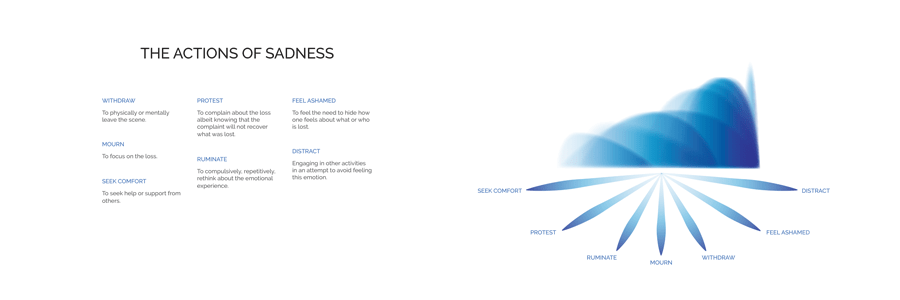“In order to get to the New World, they needed a map,” said the Dalai Lama. “In order to get to a state of calm, we need a new map.”
This map came to life at the request of the Dalia Lama, his trust provided funding to Paul and Eve Ekman to make an atlas of emotions. The Atlas was designed by Stamen Design, a firm known for its creative and elegant visualizations of data and has been upgraded and extended by designer and artist Jasper Speicher.
This was a project unlike any Stamen had tackled before.“To create the Atlas of Emotions, we started out building spreadsheets and databases, the way we typically visualize other kinds of data —but ended up like ancient mapmakers, drawing in a big leather book with pen and ink to make sure Paul and Eve’s ideas were expressed well,” said Eric Rodenbeck, Stamen’s founder,
CEO, and creative director. “It’s been a fascinating journey.”
“The goal of this work is to give people more understanding of where emotions come from—deep places, places we may have little control over—and from those emotions, how to take actions that we can control,” said Dr. Paul Ekman. “The Dalai Lama and I came to the understanding that emotions are not necessarily destructive. Emotions can be constructive if they support collaboration. We are a social species.”
Dr. Ekman Sr.’s life work has been to bring the light of science to emotions, categorizing them and showing their universality across cultures around the planet. His work has been described as following in Darwin’s footsteps. Darwin’s second book, after On The Origin Of Species, was The Expression of the Emotions in Man and Animals, arguing for an inherited basis to human behavior.
Dr. Eve Ekman is a second generation emotion researcher who focuses on reducing stress and burnout with tools of emotional awareness from a secular Buddhist and Western scientific
approach. Eve provided a learner’s perspective from the over 1,000 people she has taught about emotion skills. This father-daughter collaboration spans cultures—bringing ancient Buddhism together with Darwinism and the very latest approaches to interactive online cartography.
“I was lucky enough to first meet the Dalai Lama when I was 15, a seed was planted which I did not realize would lead to this unbelievably meaningful project.” said Dr. Eve Ekman. “The Dalia Lama’s firm belief in the simple power of knowing our emotions is an inspiration. We hope people will learn from it, that people will reflect, share and enjoy it.”
Prior to starting the project Dr. Ekman Sr. surveyed the most active emotion researchers in the world to gather the most up to date consensus on what science knows about emotion, this produced five main emotions agreed on as universally expressed and experienced. The others are fear, anger, disgust, and sadness. Pixar’s recent movie, “Inside Out,” personified these five emotions based on Dr. Ekman’s work.
“What people need to do is to learn how to counter their various emotions,” said the Dalai Lama. “Distraction is just a temporary measure. The longer-standing remedy is, for example, to be able to see positive qualities in something or someone you otherwise see as negative. Since there is
rarely any justification for destructive emotions, people need to become more aware of the causes of their emotions and how to apply antidotes to them.”
“I learned from the Dalai Lama that the Buddha cautioned his followers not to take his word onwhether the teachings work, but only to accept only what they found useful,” said Dr. Paul Ekman. “I hope people find this new tool useful—and find fun in it, too.”






